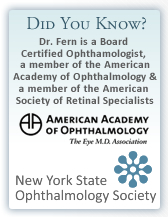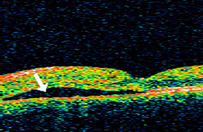|
|||||||||||
Central Serous Retinopathy
Who is at risk?The disease primarily affects young adults ages 20 to 45. Men are affected ten times more frequently than women. Coincidentally, many patients tend to live very stressful lives. What causes central serous retinopathy?The exact cause of central serous retinopathy is highly controversial. However, there appears to be an imbalance in the amount of fluid that enters the subretinal space and the ability to remove it, resulting in a net accumulation of fluid beneath the retina. Some experimental evidence suggests high blood levels of epinephrine and cortisol hormones may be responsible. What is the prognosis for central serous retinopathy?Most patients with central serous retinopathy will spontaneously recover visual acuity in six months (average time to recovery three to four months). Many patients will have some residual symptoms, such as distortion, decreased color and contrast sensitivity, and visual difficulty at night. Despite an overall good prognosis, 40 to 50 percent of patients experience at least one recurrence. Is there any treatment available?There is no medical therapy proven to be effective in treating central serous retinopathy. Laser photocoagulation treatment is said to shorten the duration of the disease; however, it does not appear to alter the final visual acuity or the recurrence rate. Treatment with laser is controversial because there are potential complications (as with any surgery) and there does not appear to be any long-term benefit to the treatment
|
| © 2023 Craig M. Fern, M.D., P.C. | Diseases & Surgery of the Retina | 105 S. Bedford Road Suite 311 Mt. Kisco, NY 10549 |
Disclaimer Privacy & Terms of Use Anti-VEGF Therapy | Laser Treatment | Retinal Detachment Repair | Fundus Photography Retinal Detachment | Fluorescein Angiography | Optical Coherence Tomography | Posterior Segment Ultrasonography Comprehensive Retina Vitreous Evaluations | Age Related Macular Degeneration |


